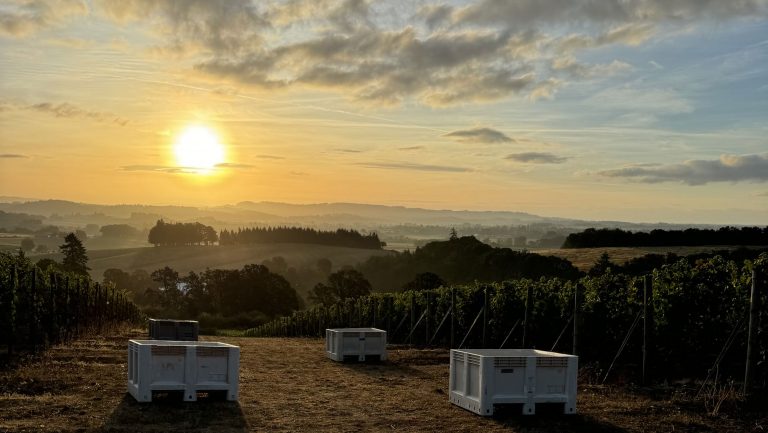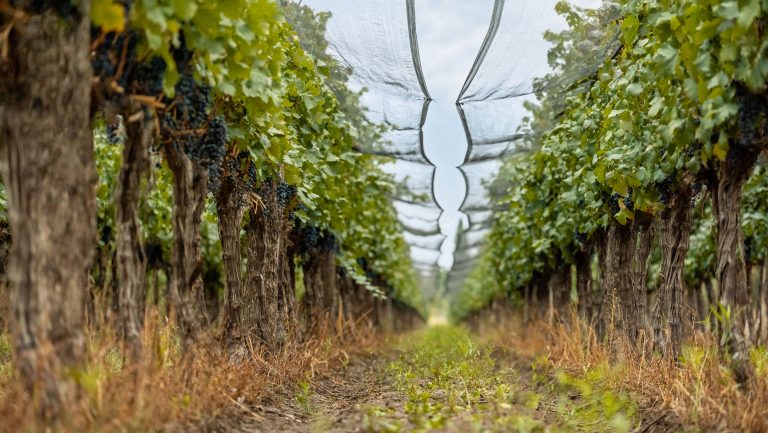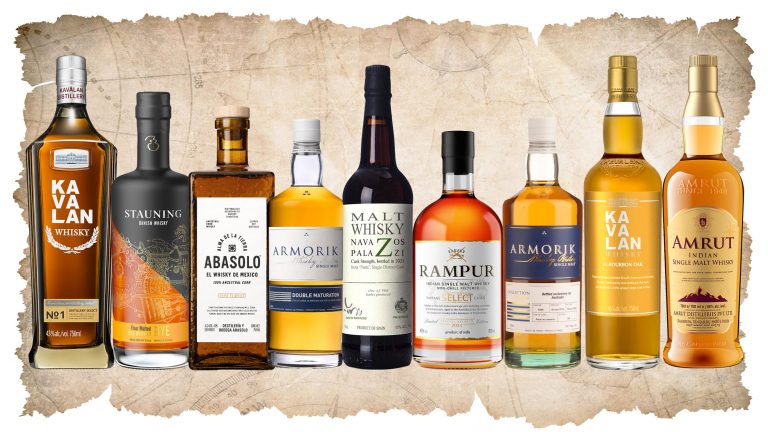Over the course of 35 years, the region of Rías Baixas has grown from a nascent appellation to, arguably, Spain’s most famous white wine region. Recent vintages have sold quickly—while the 2021 vintage is not completely sold out, according to Rías Baixas DO representatives, many wineries have sold out of their 2021 stocks—particularly in the U.S., which is the region’s top export market.
Much of this success has hinged on a single grape: Albariño, a local white variety that comprises 95 percent of the vines planted in Rías Baixas and is typically made into a bright, unoaked, approachable varietal wine. This laser-sharp focus has likely helped a tongue-twister like Rías Baixas Albariño chart a course to recognition amidst more recognizable grapes like Pinot Grigio and Sauvignon Blanc.
“The market tends to respond favorably to defined grapes and styles as it can become an easy shorthand when you’ve had a few examples,” says Jim Bube, MS, the Chicago-based wine director for Hogsalt. “Odds are very good that the bottle they pick up off of a shelf or wine list will contain that salty, crisp, and unoaked style.”

Don’t miss the latest drinks industry news and insights. Sign up for our award-winning newsletters and get insider intel, resources, and trends delivered to your inbox every week.
But as the Rías Baixas region has matured, so too have its wines. Now, producers are going beyond the signature style of wine that the region has become known for, emphasizing subregional terroir specificities, aging wines for extended periods of time, and focusing on local grape varieties beyond Albariño. A new face of Spain’s superstar white wine region is emerging—but is the market ready for it?
Making Albariño a Household Name
Founded in 1988 with just 582 hectares of vineyards, the Rías Baixas region has grown exponentially, though it remains relatively small. It’s now home to over 4,000 hectares of vines (comparatively, Spain’s blockbuster Rioja region has over 65,000 hectares planted, and Rueda, Spain’s other well-known white wine region, has 13,500 hectares of vines) and produced 27.5 million liters of wine in 2021, of which a third was exported, according to the Consejo Regulador.
“Having sold Rías Baixas wines in some capacity for about 20 years, it seems as though the category continues to get hotter every year,” says Bube. “Crisp, racy wines unencumbered by oak are having a moment in the U.S., and Rías Baixas has made a strong case for being Spain’s greatest expression of this style.”
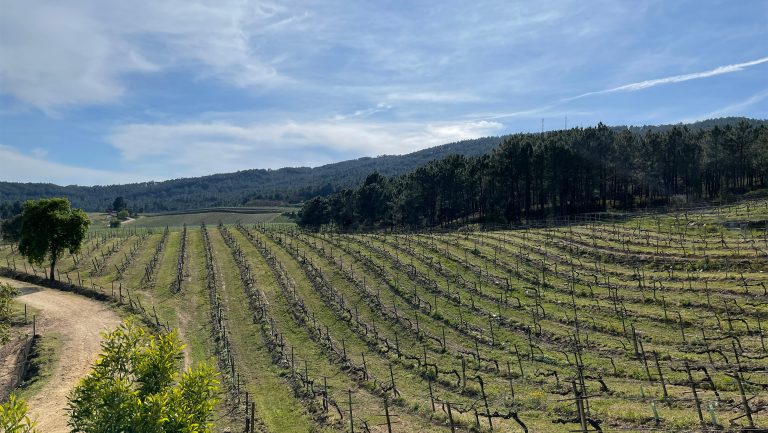
David Yoshida, a Master Sommelier who splits time between Berkeley, California and Honolulu, notes that he has seen a real following for Rías Baixas wines emerge over the past decade, when higher-end Albariños first hit the U.S. market. Though some Albariños sat above the typical $10 to $15 price point prior to this, he points to Raúl Pérez’s underwater-aged Sketch Albariño (which is produced in the region but not bottled under the Rías Baixas DO), retailing for around $100, as one of the first very expensive Albariños to reach the U.S. “It came with a story—it was rare and allocated,” says Yoshida. “It elevated Albariño.”
As consumers have become more familiar with Rías Baixas and its Albariño wines, they too have started to crave more from this region. “Consumers are demanding and looking for different, more complex, and surprising wines that they can find in Rías Baixas with the Albariño grape,” says Katia Álvarez, the winemaker for Bodegas Martin Códax in the Salnés Valley.
Getting Terroir-Specific
So what tack are local producers taking as they look to branch out? Some see potential in homing in on the land itself to highlight more specific nuances of the Rías Baixas terroir. “We often still neglect the idea of terroir in Rías Baixas by acknowledging it’s all the same,” says Matthias Lange, the international sales and marketing director for Bodegas Granbazán in the Salnés Valley. “More interesting is to talk about the diversity of terroirs, soils, and microclimates we have.”
The coastal Galician region is home to five noncontiguous subregions: from north to south, they are Ribeira do Ulla, Val do Salnés (or Salnés Valley), Soutomaior, Condado do Tea, and O Rosal. Of these, Salnés, Condado do Tea, and O Rosal are home to the vast majority of plantings; together, the newer Soutomaior and Ribeira do Ulla comprised just 1.5 percent of the region’s vinified grapes in 2019.
“I think there is a more interesting story to be told about regionality and [how] the grapes excel in these subzones than in more ambitious stylistic flexes in the winery,” says Bube. Though many wineries don’t emphasize their wines’ subregions of origin on the label just yet, most of them can be identified by subregion according to where the winery itself is located.
Sommeliers like Bube and Yoshida notice distinctive differences from one subzone to the next, in both the vineyard and the glass. “If I’m at a nice restaurant and you’re pairing Albariño, I don’t think it’s sufficient to just say ‘Rías Baixas Albariño’ at this point,” says Yoshida. “I want to know why you’re picking Rías Baixas from this subregion, knowing there are small differences.”
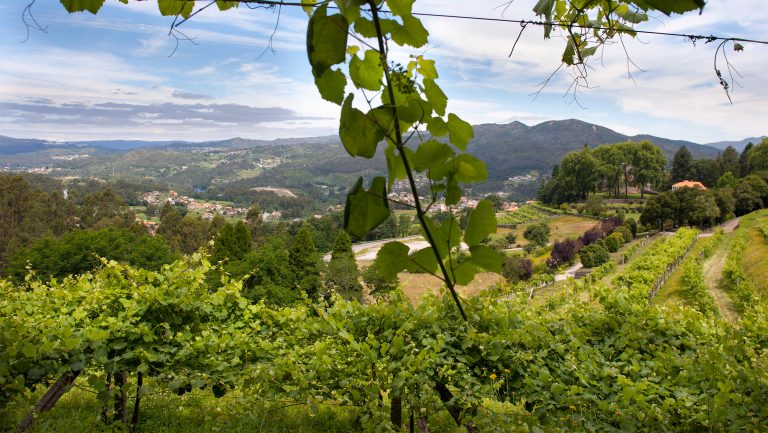
In brief, the Salnés Valley is the original core of Rías Baixas, home to the most vineyards and the most growers. Directly exposed to the Atlantic, it’s the rainiest and coolest, tending to produce the most bracing, saline wines in the region.
Condado do Tea is the second-largest subregion of Rías Baixas, located inland along the Miño River, which narrowly separates Rías Baixas from Portugal and its Vinho Verde region. Since it is largely protected from ocean influences, it is warmer and drier, producing riper, more fruit-forward wines.
O Rosal, located south of Salnés and west of Condado do Tea, sits at the intersection of the Miño River and the Atlantic Ocean. Though it has plenty of ocean influence, it has more sun and less rain than the Salnés Valley; Albariño tends to be more aromatic and floral in this area, says Luisa Freire, the winemaker for local producer Santiago Ruiz.
Highlighting specific subregions of Rías Baixas is just the beginning of emphasizing the region’s diversity. “Subregions offer us a gateway for terroir specificity. But it has to go to a vineyard level as well,” says Yoshida. “That’s one of the untapped frontiers; we don’t have many vineyard-designated Albariños.” Single-vineyard Albariños from producers like Do Ferreiro and Nanclares y Prieto remain limited.
Branching Out in the Cellar
There’s also the approach of getting experimental in the cellar. “Over the last 10 years, I think we have seen a quiet movement of change,” says Álvarez, noting that Albariño tends to maintain its personality even when subjected to different winemaking techniques. “Many producers have started to make new and different Albariño vinifications which are now reaching the market.”
Fifteen to 20 years ago, Albariño was nearly always produced as a young wine in stainless steel vessels; if a producer decided to do something different it was usually using oak, masking the grape’s quality and origin, says Álvarez. Despite the popularity of her Martin Códax and Burgans Albariños—two of the most popular and available Rías Baixas wines in the U.S. market—Álvarez is also committed to breaking the idea that Albariño is only a young wine.
“We have all the necessary ingredients to make wines with good natural aging potential by themselves through fine lees agings, bottle agings, and so on,” says Álvarez, pointing to Albariño’s natural acidity and pH levels. “So it has always been key to me to show this good natural aging potential of Albariño.” The Martin Códax Lías, for example, is aged for six months on fine lees, a further year before bottling, and another six months before release.
Pazo de Señorans, also located in the Salnés Valley, first released an aged Albariño in 1995: the Selección de Añada, which sees a minimum of 30 months on the lees and is vinified from a single plot (the current vintage on the market is 2013).

“The market was not very receptive in the beginning,” says Vicky Mareque, the winemaker and second-generation owner of Pazo de Señorans, “because at that time, people thought of Albariño as young, fresh, and fruity—but we loved the wine. Nowadays, it is very well accepted and appreciated.” The introduction of Colección in 2014, which is aged in bottle for three years with at least five months of lees aging, was much smoother as consumer attitudes had changed.
Today, it’s much more common for Rías Baixas producers to age their wines. “It allows us to show what a great variety Albariño is in Rías Baixas, able to produce old wines that have aged beautifully without oak,” says Mareque.
“It took some time to get buyers and consumers to understand the aging potential of Albariño,” agrees Lange, “but recently we have experienced much more acceptance and appreciation for it.” Most of Granbazán’s wines are aged for several months on fine lees before bottling, including market favorites Etiqueta Verde and Etiqueta Ambar, and their Limousin Albariño is aged for four to six months in large, old oak barrels.
Looking Beyond Albariño
Though the words Rías Baixas and Albariño have become somewhat synonymous, Albariño is not the only local grape planted in this region. Rías Baixas has long counted tiny but notable plots of white varieties like Loureiro, Treixadura, and Caiño Blanco and red grapes like Mencía, Sousón, Espadeiro, and Caiño Tinto—and more producers are starting to look beyond their favored variety.
Some trade professionals think this emphasizes how Rías Baixas has evolved over time. “That is a mature wine region that uses Albariño as a gateway but says, ‘We can do cool other things, too,’” says Yoshida.
O Rosal has the highest proportion of other grapes planted in its vineyards. According to 2019 production data, O Rosal vinified the highest percentage of non-Albariño grapes among the five subzones (roughly 14.5 percent of the production was non-Albariño). Condado do Tea was home to the highest production of red grapes, led by the Sousón variety.
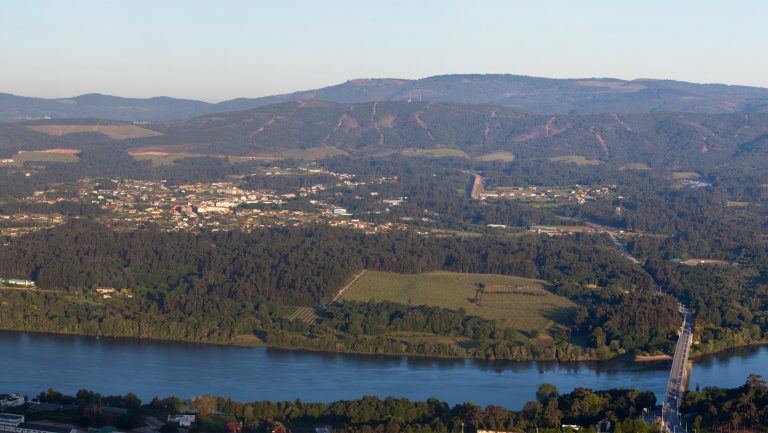
At Santiago Ruiz, the winery’s namesake cuvée is always a blend from vineyards owned by the estate—as it has been for decades. Though the Santiago Ruiz blend is predominantly Albariño, Freire is a firm believer in the potential of Loureiro from O Rosal.
Of O Rosal’s non-Albariño grapes, Caiño Blanco is the most produced—likely thanks to the efforts of Emilio Rodriguez, the winemaker for local winery Terras Gauda. “Despite being one of the most delicate varieties to grow due to its sensitivity to diseases, the variety should grow [in plantings],” he says, highlighting Caiño Blanco’s richness and complexity, capacity to age, and ability to express the region’s schistous soils.
According to the winery, Terras Gauda is home to 76 percent of the Caiño Blanco grown in the region, and Rodriguez produces a near-varietal Caiño Blanco called La Mar (the 2020 vintage included two percent of blended Albariño and Loureiro). Despite lacking the name recognition of the Albariño variety, Terras Gauda has found success thanks to their devotion to the obscure grape.
“Believe it or not, the tiny bunches of Caiño Blanco open doors for us,” says Mar Dopazo, the area manager for Grupo Terras Gauda. “Caiño makes Terras Gauda unique and links us to the O Rosal subregion.” Though he notes that they often need to offer a bit of initial explanation about the grape, more trade members and consumers are interested in learning more about other options within Rías Baixas. “Caiño Blanco grown in O Rosal was a revelation for me,” Bube confirms.
Though red wines remain fairly niche in the Rías Baixas, the success of other Galician reds—like Ribeira Sacra’s Mencía wines—could also point to opportunities for future growth. “We can’t forget that Rías Baixas makes red, which is a huge opportunity with climate change,” says Yoshida.
Rías Baixas’ Future Course
As Rías Baixas continues to evolve, it’s unlikely to abandon the acid-driven, easy-drinking style of Albariño that has charted its success thus far—nor should it. “While there will be innovators in style looking to differentiate themselves in the marketplace, I don’t see the predominant style going away,” says Bube. “Seeing a whole-scale change to oak-aging, botrytis inclusion, or very long lees aging seems to me unlikely and unwise.”
Maintaining availability and accessibility of these entry-level wines will be important for Rías Baixas, particularly because demand has grown so much. “They cannot let the wine become too expensive, so they need to grow their supply at the introductory level,” says Yoshida. He posits that the region could use available land in Soutomaior and Ribeira do Ulla, two subzones that were traditionally not planted as readily due to frost concerns.

Availability of more premium wines is an issue as well; more specialized cuvées from large and mid-sized producers are limited in production, and smaller producers like Bodegas Albamar, Forjas del Salnés, and Nanclares y Prieto own only a handful of vineyard hectares (though some purchase grapes as well). Vineyard ownership in Rías Baixas is fragmented; there are over 5,000 growers for the region’s 4,000 hectares.
Still, many producers see more terroir-specific and longer-aged wines, potentially from a wider range of varieties, as the future for their region. “These are the wines that are positioning Rías Baixas among one of the most premium white wine regions in the world,” says Álvarez.
“We need to continue the path of showing the premium aspects of Albariño: aging potential and diversity of terroirs,” adds Lange.
For them, it’s a signal that Rías Baixas has come into its own. “Rías Baixas has evolved to a more professional area, with an interest in new methods of winemaking and more premiumization of our wines,” says Dopazo. “We’re a region with an international calling, and the only challenge in the years to come is being able to supply the increasing international demand.”

Dispatch
Sign up for our award-winning newsletter
Don’t miss the latest drinks industry news and insights—delivered to your inbox every week.
Courtney Schiessl Magrini is the editor-in-chief for SevenFifty Daily and the Beverage Media Group publications. Based in Brooklyn, she has held sommelier positions at some of New York’s top restaurants, including Marta, Dirty French, and Terroir, and her work has appeared in Wine Enthusiast, GuildSomm, Forbes.com, VinePair, EatingWell Magazine, and more. She holds the WSET Diploma in Wines. Follow her on Instagram at @takeittocourt.




